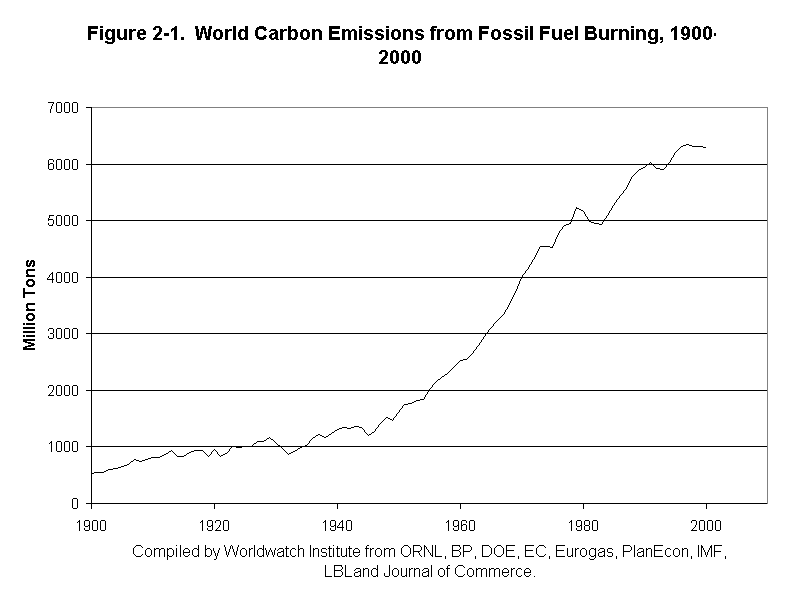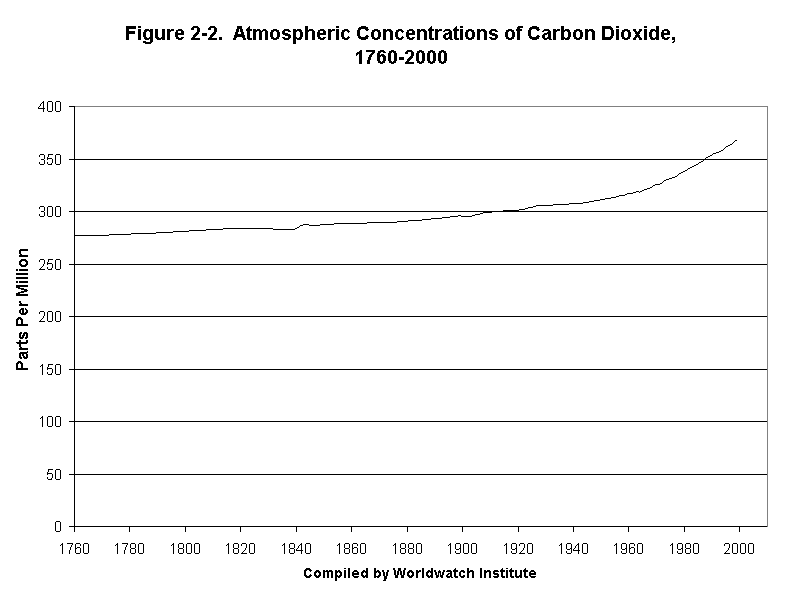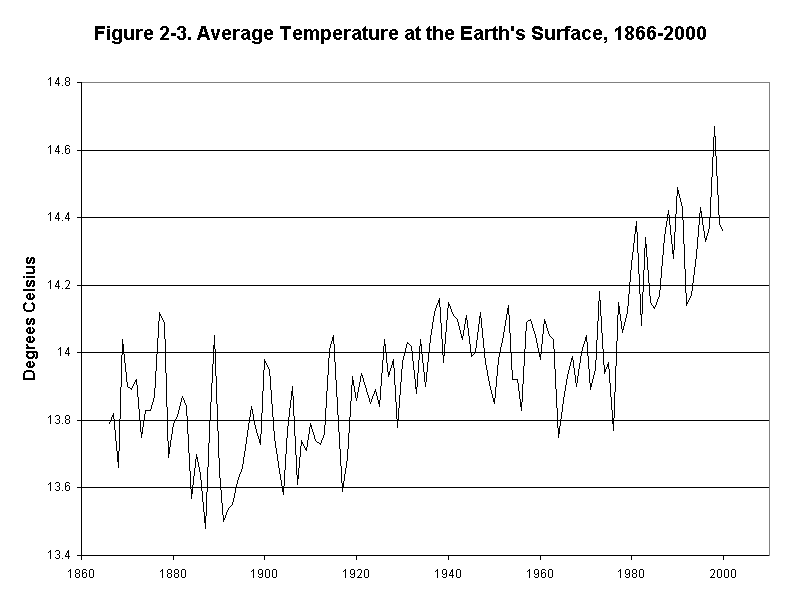"I appreciate…the hope Plan B communicates by pointing out so many things that are already being done around the globe." —Roland Saher, economics teacher on Plan B 4.0: Mobilizing to Save Civilization.
Chapter 2. Signs of Stress: Climate & Water: Temperature Rising
Since agriculture began, the earth's climate has been remarkably stable. Now the earth's temperature is rising, apparently due to the greenhouse effect—the warming that results from the rising concentration of heat-trapping gases, principally carbon dioxide (CO2), in the atmosphere.
This rise in CO2 concentration comes from two sources: the burning of fossil fuels and deforestation. Each year, more than 6 billion tons of carbon are released into the atmosphere as fossil fuels are burned. Estimates of the net release of carbon from deforestation vary widely, but they center on 1.5 billion tons per year.5
The release of CO2 from these two sources is simply overwhelming nature's capacity to fix carbon dioxide. When the Industrial Revolution began in 1760, carbon emissions from the burning of fossil fuels were negligible. But by 1950, they had reached 1.6 billion tons per year, a quantity that was already boosting the atmospheric CO2 level. In 2000, they totaled 6.3 billion tons. (See Figure 2-1.) This fourfold increase since 1950 is at the heart of the greenhouse effect that is warming the earth.6
The carbon emissions of individual fossil fuels vary. Coal burning releases more carbon per unit of energy produced than oil does, and oil more than natural gas. The global fleet of 532 million gasoline-burning automobiles, combined with thousands of coal-fired power plants, are literally the engines driving climate change.7
In addition, in recent years the world has been losing 9 million hectares of forest per year. Forests store easily 20 times as much carbon per hectare as does land in crops. If the net loss of forests can be eliminated, this source of carbon emissions will disappear. In the northern hemisphere, the forested area is actually increasing by 3.6 million hectares a year. The big challenge is to arrest and reverse the deforestation in developing countries.8
At the start of the Industrial Revolution in 1760, the atmospheric CO2 concentration was estimated at 280 parts per million (ppm). By 2000, it had reached 370 ppm, a rise of 32 percent from pre-industrial levels. (See Figure 2-2.) The buildup of atmospheric CO2 from 1960 to 2000 of 54 ppm far exceeded the 36 ppm rise from 1760 to 1960.9
Atmospheric CO2 levels have risen each year since annual measurements began in 1959, making this one of the most predictable of all environmental trends. Physics textbooks point out that as atmospheric CO2 levels rise, so will the earth's temperature, and this is exactly what is happening. As noted earlier, the 14 warmest years since recordkeeping began have all come since 1980. Over the last three decades, global average temperature has risen from 13.99 degrees Celsius in 1969-71 to 14.43 degrees in 1998-2000, a gain of 0.44 degrees Celsius (0.8 degrees Fahrenheit).10
The dramatic rise in the earth's temperature since 1980 can be clearly seen in Figure 2-3. Not only is it rising rapidly, but it is projected to rise even faster in the next century. If CO2 concentrations in the atmosphere double pre-industrial levels by the end of this century, reaching 560 ppm, the temperature is projected to rise by 1.4-5.8 degrees Celsius. Rising temperatures lead to more extreme climatic events—record heat waves, the melting of ice, rising sea level, and more destructive storms.11
Projected temperature rises will not be distributed evenly over the earth's surface, but will be greater over land areas than over the oceans and also greater in the higher latitudes than in the equatorial regions. Inland regions in northern latitudes can expect some of the biggest temperature jumps. A taste of what is to come can be seen in the July 1995 heat wave in Chicago, when temperatures reached 38-41 degrees Celsius (100-106 degrees Fahrenheit) on five consecutive days. Although Chicago is a modern industrial city with extensive air conditioning, this heat wave claimed more than 500 lives. And because Chicago is in the center of the U.S. Corn Belt, the intense heat also helped shrink the 1995 U.S. corn harvest by some 15 percent or $3 billion.12



ENDNOTES:
5. Fossil fuel-related carbon emissions figure from Seth Dunn, "Carbon Emissions Continue Decline," in Worldwatch Institute, Vital Signs 2001 (New York: W.W. Norton & Company, 2001), p. 53; WRI estimates emissions of 1.6 billion tons carbon per year from land use change, most of which is related to deforestation, in WRI, op. cit. note 4, p. 101.
6. Figure 2-1 from Dunn, op. cit. note 5.
7. Carbon and fossil fuels information from Energy Information Administration, Annual Energy Outlook 2001, with Projections to 2020 (Washington, DC: U.S. Department of Energy, 2000), p. 48; Michael Renner, "Vehicle Production Sets New Record," in Worldwatch Institute, op. cit. note 5, p. 68.
8. Changing forest cover from U.N. Food and Agriculture Organization (FAO), Forest Resources Assessment (FRA) 2000, www.fao.org/forestry/fo/fra/index.jsp, updated 10 April 2001, but see note in Chapter 8 on variations among estimates; forests store 20 to 100 times more carbon than cleared land, according to Mohan Wali et al., "Assessing Terrestrial Ecosystem Sustainability: Usefulness of Regional Carbon and Nitrogen Models," Nature & Resources, October-December 1999, p. 27.
9. Figure 2-2 from Dunn, op. cit. note 5, pp. 52-53.
10. Hansen, op. cit. note 2; Seth Dunn, "Global Temperature Steady," in Worldwatch Institute, op. cit. note 5, pp. 50-51.
11. Intergovernmental Panel on Climate Change (IPCC), "Climate Change 2001: Impacts, Adaptation, and Vulnerability (Summary for Policy Makers)" (draft Feb 2001), www.ipcc.ch/pub/wg2SPMfinal.pdf ; Figure 2-3 based on Hansen, op. cit. note 2.
12. Cindy Schreuder and Sharman Stein, "Heat's Toll Worse Than Believed, Study Says at Least 200 More Died," Chicago Tribune, 21 September 1995; corn harvest data from U.S. Department of Agriculture (USDA), Production, Supply, and Distribution, electronic database, Washington, DC, updated May 2001.
Copyright © 2001 Earth Policy Institute

